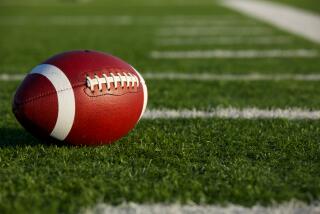THE TIMES 100: THE BEST COMPANIES IN CALIFORNIA : WHO, WHAT & WHERE : TALLYING THE SCORE
- Share via
This special section is designed to offer insight into California’s business environment and a scorecard on the performance of firms headquartered in the state.
The information was collected and analyzed by MZ Group, a business analysis firm in San Francisco (415-885-5551) headed by Mansoor Zakaria and Kevin Colosimo.
MZ gathered information on 989 California-based companies whose stock is publicly traded, relying upon databases, corporate and government reports, a mail survey and direct telephone contact with company representatives. The tables generated by MZ were reviewed closely by Times editors and reporters. Criteria for the rankings were developed jointly by The Times and MZ representatives.
MZ Group used financial data as reported at a company’s fiscal year-end for 1985, 1986 and, if available, 1987. If 1987 fiscal year-end data was unavailable when data was compiled, the previous four quarters were compared to 1986 fiscal results. (See table on page 12 for such instances.)
If a company’s fiscal year ends between January and May, its financial results are reported under the previous calendar year. For example, the financial data for a company completing its fiscal year in February, 1986, will be reported as 1985 results.
Financial data for 1985 and 1986 have not been restated for acquisitions and/or discontinued operations. This allows the reader to see actual historical growth for the company, whether from internal growth or through acquisitions.
A few companies have majority-owned subsidiaries that are publicly traded as separate entities. The financial results for these subsidiaries are presented independently as well as on a consolidated basis in the accounts of the parent company. This applies to the following companies: Caesars World (parent) and Caesars New Jersey; ICN Pharmaceuticals (parent), SPI Pharmaceuticals, ICN Biomedicals and Viratek, and Kaufman & Broad (parent) and Kaufman & Broad Homes.
All companies must be publicly traded and have their headquarters in California. Real estate investment trusts and limited partnerships were not eligible, because income for these companies, which is not taxed at the corporate level, is not comparable to after-tax income for corporations.
1987 income is defined as after-tax income from continuing operations and excludes one-time extraordinary items, and gains or losses from discontinued operations. For insurance companies, income also includes after-tax gains or losses on investments.
1987 sales exclude excise taxes, extraordinary income, revenue from discontinued operations, and other income, such as interest. For banks and savings and loan associations, revenues equal the sum of interest and non-interest income. For insurance firms, revenues equal the sum of earned premiums and net investment income.
Section notes
THE BOTTOM LINE--Return on equity measures the profit a company earns for every dollar stockholders have invested in the firm. Return on equity is defined as income available to common shareholders divided by the average common shareholder’s equity.
For The Times 100 table, companies must have met the following criteria: publicly traded since January, 1985; sales in 1987 greater than $50 million; shown a profit from continuing operations in 1987 and 1986; must not have reported negative common equity for the last three fiscal years, and must not have more than twice as much long-term debt as total shareholders’ equity.
The Top 25 Banks and S&Ls; tables shows return on assets, which measures percentage profit for every dollar in assets. Companies must have been publicly traded since 1986. Total assets must have exceeded $1 billion.
VIEW FROM THE STREET--Market value generally measures the esteem in which investors hold a company’s stock and the confidence that they have in its future success. Market value is the stock price times the number of outstanding shares. Book value is total shareholders’ equity or assets minus liabilities. A company’s stock must be available for trading on one of the major exchanges and must have traded on April 4, 1988.
For the Favorites and Forlorn tables, a company’s 1987 sales must have exceeded $10 million.
For the Charging Ahead table, a company’s stock must have been available for trading on a major public exchange on Dec. 31, 1986, and on that day must have exceeded $2 a share. Stock prices as of that day have been adjusted to reflect stock splits and dividends. Cash dividend is the current annual dividend for the stock. There is no guarantee that the company will actually pay this amount.
For the Value Gainers, “Undervalued” and “Overvalued,” a firm’s market value on April 4, 1988, must have exceeded $100 million.
GROWTH--Sales growth can come either by generating new business or acquiring other firms. A company must have been publicly traded in 1985. 1985 sales must have exceeded $30 million.
To be eligible for the Fast Track to Profits table, a company must have been publicly traded and shown a profit from continuing operations for the past three years, and must have had at least $10 million in income from continuing operations in 1985.
THE HUMAN FACTOR--Employees represent full- and part-time employment at fiscal year-end, excluding consultants and contractors. Figures are estimates provided by the company. For employee productivity table, company must have had 1987 sales in excess of $50 million. Hiring data was obtained from the companies.
REGIONAL PROFILES--Same criteria as for main tables, except for Growth data for San Diego, for which a company must have minimum 1985 sales of $10 million.
WHO, WHAT, WHERE--Profiles have been included for all companies appearing on The Times 100 list of profitability.
Stock exchange symbols are as follows: NYSE, New York Stock Exchange; Amex, American Stock Exchange; NASDAQ, National Assn. Securities Dealers Automated Quotations, and OTC for over-the-counter.
More to Read
Inside the business of entertainment
The Wide Shot brings you news, analysis and insights on everything from streaming wars to production — and what it all means for the future.
You may occasionally receive promotional content from the Los Angeles Times.









